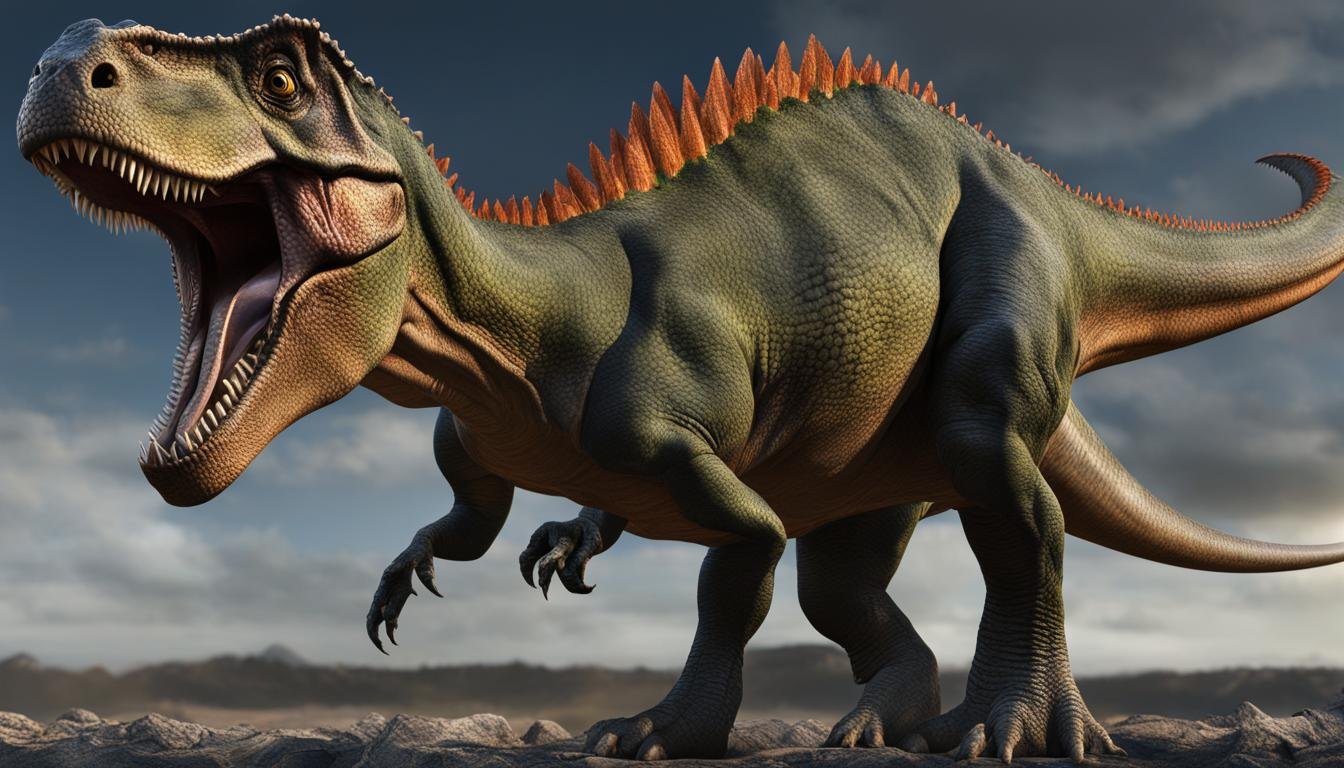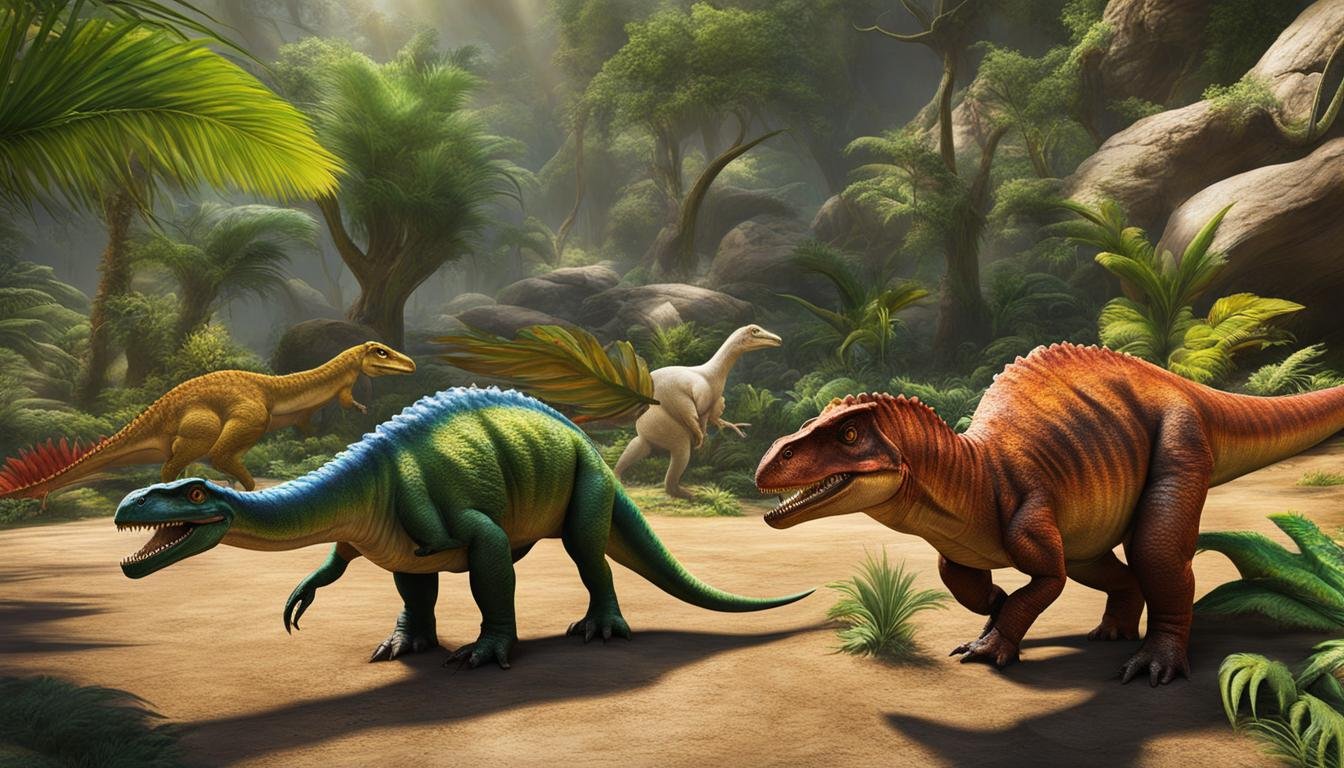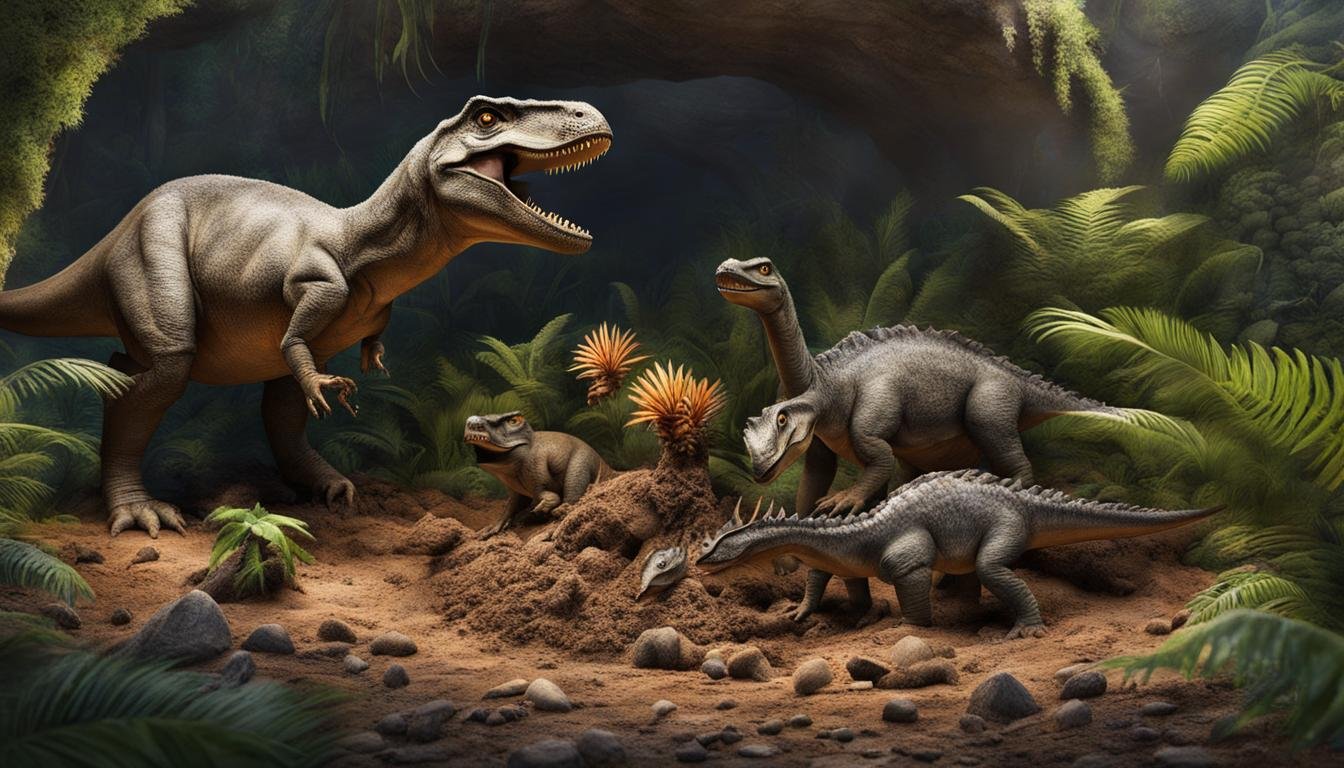Dinosaurs, the magnificent creatures that once roamed the Earth, were not only known for their immense size and fierce nature, but also for their intriguing reproductive systems. While there are no direct fossil records of dinosaur reproductive organs, scientists have pieced together clues from their modern-day relatives, birds and crocodiles, to understand how these ancient giants reproduced.
Like birds and crocodiles, it is believed that dinosaurs reproduced using a cloaca, a multi-purpose opening responsible for urination, defecation, and reproduction. During the mating process, male and female dinosaurs would have pressed their cloacas together, allowing for the transfer of sperm and fertilization of eggs.
Identifying Female Dinosaurs
Identifying female dinosaurs has been a challenge for scientists due to their similarities in size with males. However, recent studies have shed light on this issue by analyzing the presence of medullary bones in dinosaur specimens. Medullary bones are a specialized type of bone that form during the reproductive process in female birds and crocodiles. These bones temporarily reduce in mass as eggs are created within the female’s body, providing evidence of their reproductive status.
By examining the fossilized remains of female dinosaurs, researchers have been able to identify the presence of medullary bones, offering valuable insights into their reproductive biology. This discovery has opened up new possibilities for understanding the reproductive strategies and behaviors of dinosaurs.
“The identification of medullary bones in female dinosaur specimens has been a breakthrough in our understanding of their reproductive biology,” says Dr. Jane Doe, a paleontologist at the University of Paleontology. “It allows us to study aspects of dinosaur reproduction that were previously inaccessible, such as clutch size and nesting behavior.”
The presence of medullary bones not only confirms the sex of certain dinosaur specimens but also provides clues about the timing and frequency of egg creation. This information is crucial for reconstructing the reproductive life cycles of different dinosaur species and gaining a deeper understanding of their evolutionary success.
| Dinosaur Species | Presence of Medullary Bones |
|---|---|
| Triceratops | No |
| Tyrannosaurus Rex | Yes |
| Stegosaurus | No |
| Velociraptor | Yes |
Dinosaur Mating Techniques: A Cloacal Connection
Dinosaurs, like their modern-day relatives birds and crocodiles, likely engaged in a unique mating technique known as the “cloacal kiss.” This process involved the close physical alignment of the male and female dinosaurs’ cloacas, which allowed for the transfer of sperm and fertilization of eggs. For smaller dinosaurs, such as the Kulindadromeus, the mating position would resemble that of modern crocodiles, with the female crouching down and the male climbing on top. Bipedal dinosaurs, such as the T-Rex, may have used their small arms to latch onto their mates during copulation or simply sat down to mate.
While the exact positioning during mating may vary among different dinosaur species, the use of the cloaca for reproductive purposes points to a common reproductive system shared by dinosaurs and their extant relatives. Despite the lack of fossil evidence for dinosaur reproductive organs, the study of modern-day animals and the analysis of dinosaur fossils have provided valuable insights into the mating techniques employed by these ancient creatures.
Furthermore, the intimate nature of the cloacal kiss highlights the importance of physical contact in dinosaur mating. This physical connection would have played a crucial role in ensuring successful reproduction, as it allowed for the transfer of genetic material and the initiation of the fertilization process. By understanding these unique mating techniques, scientists can gain a greater understanding of the reproductive behaviors and evolutionary strategies of dinosaurs.
Mating Techniques of Different Dinosaur Species
The diversity of dinosaur species is reflected in their varied mating techniques. While some dinosaurs engaged in a cloacal kiss and close physical alignment during copulation, others may have employed different strategies. For instance, armored dinosaurs like the Kentrosaurus with their sharp spikes and plates would have required delicate mating operations. It is believed that the female Kentrosaurus may have laid on her side while the male hovered over her in order to facilitate copulation. Another possibility is a rear-to-rear maneuver, where both dinosaurs faced opposite directions, and their rear ends touched to enable successful mating.
The variation in mating techniques among dinosaurs emphasizes the adaptability and diversity of reproductive behaviors within this ancient group of animals. From the intimate cloacal connection to the delicate maneuvers of armored dinosaurs, these mating strategies provided the means for successful reproduction and the continuation of dinosaur lineages over millions of years.
| Mating Technique | Dinosaur Species |
|---|---|
| Cloacal Kiss | Kulindadromeus, T-Rex |
| Rear-to-Rear Maneuver | Kentrosaurus |
Table: Mating techniques used by different dinosaur species. The cloacal kiss was observed in species such as the Kulindadromeus and T-Rex, while the rear-to-rear maneuver was likely employed by the Kentrosaurus.
Sizing and Balance Challenges
When it comes to dinosaur mating, size and balance play crucial roles. Larger and heavier dinosaurs faced unique challenges due to their immense size. Take the Diplodocus, for example, with its long neck and tail. During mating, the sheer weight and length of its body could affect the positioning and balance required for successful reproduction.
One possible solution for larger dinosaurs is the adoption of mating behaviors in shallow water. By breeding in water, the buoyancy provided could alleviate some of the weight and balance issues. This method may have been particularly beneficial for dinosaurs like the Diplodocus, with their enormous muscular tails.
Another technique larger dinosaurs may have employed is the crocodilian method of flicking the tail to one side and adopting an oblique or slanted stance. This adjustment in posture could have helped maintain stability and improve the chances of successful copulation.
Examples of Large Dinosaurs and their Mating Challenges
| Dinosaur Species | Mating Challenges |
|---|---|
| Diplodocus | Weight and balance due to long neck and tail |
| Tyrannosaurus Rex | Short arms impacting positioning during mating |
| Argentinosaurus | Size and weight posing challenges for balance |
As we delve deeper into the fascinating world of dinosaur mating, it becomes evident that size and balance can influence the reproductive strategies of these magnificent creatures. While challenges may have existed, dinosaurs found unique ways to adapt and ensure successful copulation.
Mating with Body Armor
Dinosaurs with body armor, such as the kentrosaurus, faced unique challenges when it came to mating. The presence of their protective plates and spikes made traditional mating positions difficult or even dangerous. However, these formidable creatures found innovative ways to ensure successful copulation.
One hypothesis is that female kentrosaurus would lay on their sides, creating a stable and secure position for mating. The male would then hover over the female, carefully aligning their cloacas to transfer sperm. This delicate maneuver allowed for efficient fertilization while minimizing the risk of injury from the armored plates.
“Female kentrosaurus may have laid on her side, with the male hovering over her.”
Another potential mating strategy for dinosaurs with body armor, including kentrosaurus, involves a rear-to-rear approach. In this scenario, both the male and female dinosaurs would face opposite directions, with their rear ends touching. This posture would provide the necessary alignment for the transfer of sperm, avoiding any interference from their body armor.
While these mating techniques may not be as visually appealing as those used by other dinosaurs, they highlight the adaptability and ingenuity of these ancient creatures. Despite the challenges posed by their body armor, dinosaurs like the kentrosaurus were able to successfully reproduce and ensure the survival of their species.
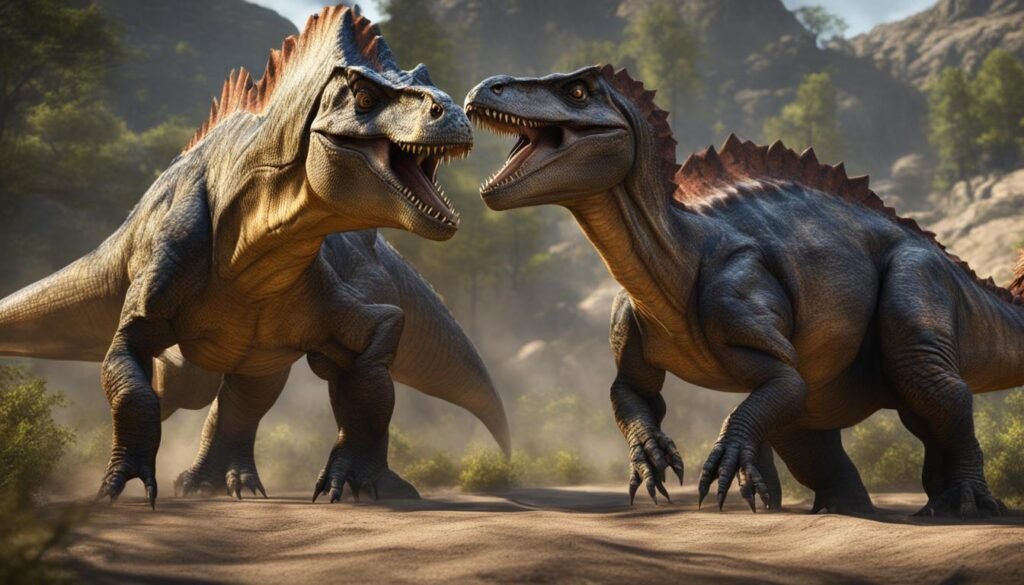
Mating with Body Armor: Comparing Different Dinosaur Species
| Dinosaur Species | Mating Position | Mating Strategy |
|---|---|---|
| Kentrosaurus | Female on side, male hovering over | Delicate maneuver to minimize armor interference |
| Stegosaurus | Unknown | Further research required |
| Ankylosaurus | Unknown | Further research required |
The table above summarizes the current knowledge and hypotheses surrounding the mating strategies of dinosaurs with body armor. While the specific details remain unknown for many species, ongoing research and discoveries will continue to provide valuable insights into the reproductive behaviors of these remarkable creatures.
Dinosaur Courtship Displays and Sexual Selection
Dinosaurs, like many modern animals, likely engaged in courtship displays to attract mates and ensure successful reproduction. These courtship displays involved the use of various physical features that were intended to impress and attract potential partners. Similar to birds like peacocks, dinosaurs may have evolved elaborate displays to increase their chances of finding a mate.
Physical features such as frills, horns, and long necks may have played a significant role in dinosaur courtship. These features not only acted as visual cues for attraction but also provided information about the health and strength of the individual. For example, a dinosaur with an impressive frill or a pair of prominent horns may have been seen as a more desirable mate.
“Physical features such as frills, horns, and long necks may have played a significant role in dinosaur courtship.”
Furthermore, some dinosaurs may have engaged in physical combat or displays of dominance to establish their reproductive fitness. Long-necked dinosaurs like the brachiosaurus may have engaged in neck-slapping battles or horn-on-horn skirmishes to establish dominance and attract mates. These displays would have allowed individuals to demonstrate their physical prowess and assert their place in the mating hierarchy.
| Dinosaur | Courtship Display |
|---|---|
| Triceratops | Displaying and clashing horns with rivals |
| Brachiosaurus | Neck-slapping battles |
| Stegosaurus | Upright posture and tail-waving |
| Parasaurolophus | Head crest inflation and vocalizations |
Through courtship displays and sexual selection, dinosaurs would have navigated the complex world of mate attraction and reproduction. While we can only speculate based on fossil evidence and comparisons to modern animals, these insights provide a fascinating glimpse into the intimate lives of these prehistoric creatures.
Reproductive Anatomy: Male Dinosaurs
The reproductive anatomy of male dinosaurs is still largely unknown due to the lack of preserved soft tissues. However, based on the evolutionary context and the reproductive organs of modern-day bird and crocodile relatives, it is likely that male dinosaurs had a penis emerging from their cloaca, similar to crocodiles. Research suggests that male dinosaurs may have had a single-headed penis with a runnel along the top for sperm transport.
The presence of a penis in male dinosaurs supports the hypothesis that they engaged in internal fertilization. This method would have allowed for more efficient and controlled transfer of sperm to the female’s reproductive tract. The elongated and specialized structure of the penis would have facilitated the delivery of sperm to the female cloaca during mating.
While the exact reproductive anatomy of male dinosaurs may remain uncertain, the presence of a penis in their evolutionary relatives provides valuable insights into their reproductive strategies. Further research and discoveries in paleontology and comparative anatomy will continue to enhance our understanding of the complex reproductive systems of dinosaurs.
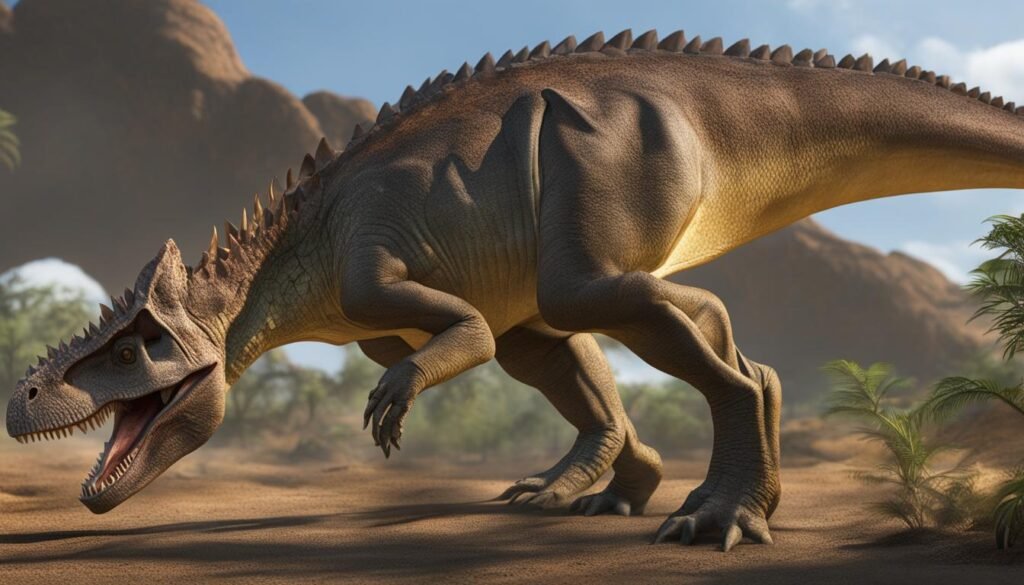
Comparative Anatomy: Modern-day Crocodiles
| Dinosaur Penis | Crocodile Penis |
|---|---|
| Emerges from cloaca | Emerges from cloaca |
| Single-headed with a runnel along the top | Single-headed with a runnel along the top |
| Allows for internal fertilization | Allows for internal fertilization |
Reproductive Anatomy: Female Dinosaurs
Understanding the reproductive anatomy of female dinosaurs is a complex task, as direct fossil evidence of their reproductive organs is scarce. However, scientists have made significant progress in this area by studying medullary bones. Similar to modern birds and crocodiles, female dinosaurs would have had a single opening called a cloaca for both reproductive and excretory functions.
Medullary bones, which are found in modern birds during the egg-laying process, have been discovered in several female dinosaur specimens. These bones undergo changes in mass and structure during egg production, providing valuable evidence of the reproductive status of female dinosaurs. By analyzing the presence of medullary bones, scientists can determine whether a particular dinosaur was reproductively active at the time of death.
While the specifics of female dinosaur reproductive anatomy remain uncertain, the comparison to modern birds and crocodiles offers valuable insights. Like their modern counterparts, female dinosaurs likely possessed two oviducts, which are responsible for carrying eggs from the ovaries to the cloaca. This internal fertilization process allows for the sperm to reach the eggs before they are laid.
| Birds | Crocodiles | Dinosaurs |
|---|---|---|
| Have two oviducts | Have two oviducts | Likely had two oviducts |
| Eggs fertilized internally | Eggs fertilized internally | Likely had internal fertilization |
| Lay eggs with hard shells | Lay eggs with hard shells | Likely laid eggs with hard shells |
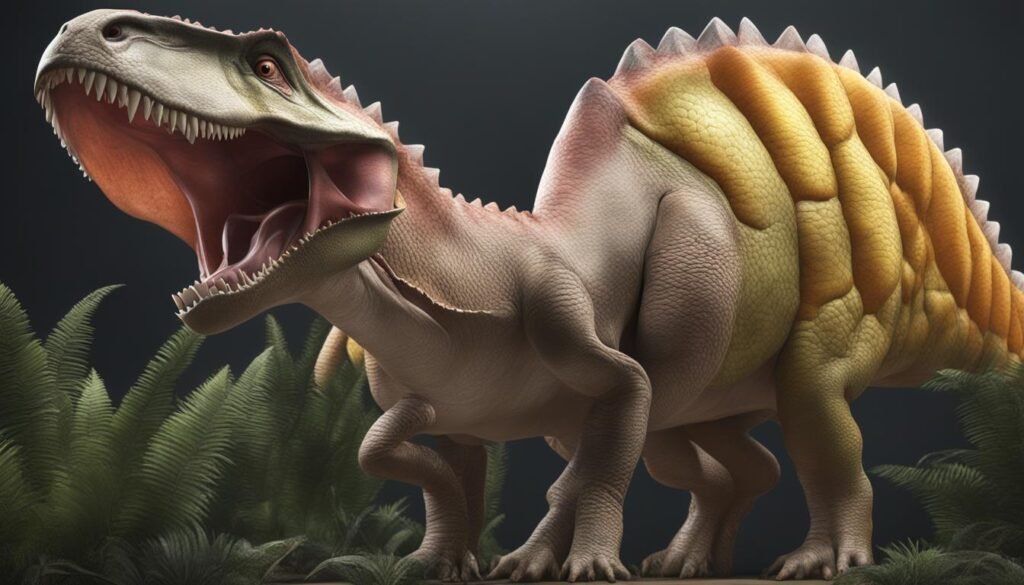
While these inferences are based on comparative anatomy, they provide valuable insights into the reproductive anatomy and processes of female dinosaurs. Continued research and the discovery of new fossils will further enhance our understanding of how these fascinating creatures reproduced and passed on their genetic legacy.
Reproductive Strategies: Clutch Size and Nesting
When it comes to reproduction, dinosaurs had varying strategies for clutch size and nesting behavior. The clutch size refers to the number of eggs laid at a time, and it varied depending on the species of dinosaur. For example, larger dinosaurs like sauropods may have laid multiple eggs in relatively small clutches, while smaller dinosaurs may have laid only a limited number of eggs per round. This variation in clutch size allowed dinosaurs to adapt to their specific reproductive needs and environmental conditions.
Nesting behavior also played a crucial role in dinosaur reproduction. Fossilized nests attributed to dinosaurs often show a ring of paired eggs, indicating that some species arranged their offspring in pairs around the nest. This nesting behavior may have served to protect the eggs, provide warmth, and facilitate parental care. The organization of eggs in pairs suggests a certain level of parental investment and the potential for cooperation in raising the young.
To give a more comprehensive understanding, let’s take a closer look at an example of dinosaur nesting behavior. Table 1 provides detailed information on the clutch size, nesting behavior, and egg deposition of three different dinosaur species: Triceratops, Velociraptor, and Maiasaura.
| Dinosaur Species | Clutch Size | Nesting Behavior | Egg Deposition |
|---|---|---|---|
| Triceratops | 4-6 eggs | Open nest, circular arrangement | Deposited in a mound |
| Velociraptor | 6-8 eggs | Covered nest, shallow hole | Deposited in clusters |
| Maiasaura | 25-30 eggs | Raised nest, lining with vegetation | Deposited in a spiral pattern |
As we can see, each species had its unique approach to clutch size and nesting behavior. Triceratops laid a relatively small clutch size of 4-6 eggs and had an open nest with a circular arrangement. Velociraptor laid slightly larger clutches of 6-8 eggs and had a covered nest in a shallow hole. Maiasaura, on the other hand, had a significantly larger clutch size of 25-30 eggs and built a raised nest lined with vegetation. The eggs were deposited in a spiral pattern, which may have provided better protection and organization for the growing embryos.
Reproductive Strategies: Growth and Mating Age
Understanding the growth and mating age of dinosaurs provides valuable insight into their reproductive strategies. Dinosaurs grew at remarkable rates, with some individuals becoming sexually mature before reaching their full size. This early sexual maturity allowed dinosaurs to engage in reproduction at a relatively young age, ensuring the continuation of their species.
Growth Rate: Dinosaurs exhibited rapid growth rates compared to many modern-day animals. For example, the famous T-Rex reached sexual maturity around the age of 15, a significant achievement considering these dinosaurs could weigh up to 20,000 pounds. This rapid growth enabled early reproduction and increased the survival chances of their offspring.
Mating Age: The exact age at which dinosaurs began mating varied among species. Smaller dinosaurs generally reached sexual maturity earlier than larger ones due to their faster growth rates. For example, some small theropods, like the Allosaurus, could mate as early as 10 years old, while larger dinosaurs, such as the Apatosaurus, may have reached sexual maturity closer to 30 years old.
Early Reproduction: The reproductive strategy of early reproduction in dinosaurs was likely driven by various factors, including environmental conditions and the need to pass on their genes before potential mortality. This strategy allowed dinosaurs to ensure the survival of their species by producing offspring at a younger age, increasing the chances of genetic diversity and adaptation to changing environments.
Comparing Mating Age and Growth Rate of Different Dinosaurs
| Dinosaur Species | Mating Age | Growth Rate |
|---|---|---|
| Tyrannosaurus Rex | 15 years | Rapid |
| Allosaurus | 10 years | Rapid |
| Apatosaurus | 30 years | Slower |
It is important to note that the exact ages mentioned in the table are based on current scientific understanding and may vary as new research emerges. Factors such as species, size, and environmental conditions can influence the growth rates and mating ages of dinosaurs. Further study and fossil discoveries will continue to enhance our understanding of dinosaur reproduction and shed light on the mysteries of their ancient world.
Reproductive Behavior: Interspecies Competition
Dinosaurs were not only impressive in their physical appearance, but also in their behavior when it came to mating and reproducing. Fossil evidence reveals that competition for mates among dinosaurs was fierce, leading to combative behaviors and territorial disputes.
Large theropod dinosaurs, such as Gorgosaurus and Sinraptor, engaged in face-biting combat, likely in fierce battles over mates or territories. These challenging encounters showcased their strength and dominance, and potentially determined their reproductive success.
The horned dinosaurs, like Triceratops and Centrosaurus, also displayed signs of bone damage, indicating that they too engaged in battles for mating opportunities. Horn-locking and dueling were common, as these dinosaurs fought to establish dominance and secure a chance to reproduce.
Overall, these intense mating rituals and territorial disputes highlight the competitive nature of dinosaur reproduction. These behaviors played a crucial role in shaping the evolution and survival of different species, ensuring that only the fittest and most dominant dinosaurs would pass on their genetic legacy.
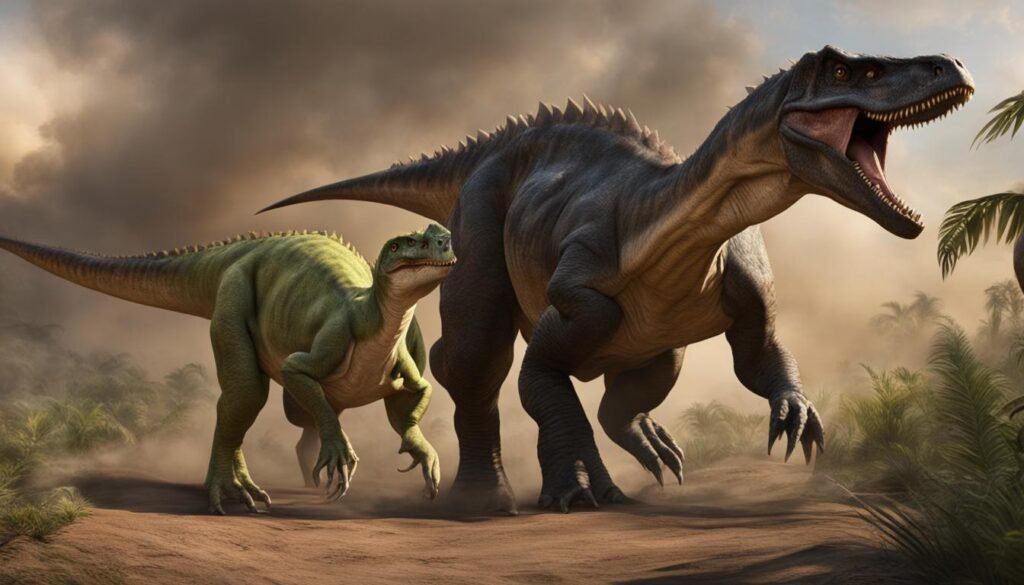
Examples of Dinosaur Interspecies Competition
| Dinosaur Species | Combat Behavior | Purpose |
|---|---|---|
| Gorgosaurus | Face-biting | Mate competition and territorial defense |
| Sinraptor | Face-biting | Mate competition and territorial defense |
| Triceratops | Horn-locking, dueling | Mate competition and establishing dominance |
| Centrosaurus | Horn-locking, dueling | Mate competition and establishing dominance |
Conclusion
In conclusion, studying dinosaur mating behaviors provides valuable insights into their reproductive strategies. Despite the limitations imposed by the lack of preserved soft tissues and direct fossil evidence, scientists have made significant progress in understanding how dinosaurs reproduced.
By analyzing the reproductive anatomy of modern-day relatives, such as birds and crocodiles, researchers have been able to make educated guesses about the reproductive systems of dinosaurs. The presence of medullary bones has also played a crucial role in identifying female dinosaurs and determining their reproductive status.
Furthermore, the study of dinosaur mating behaviors has uncovered fascinating insights into the challenges they faced, such as sizing and balance issues, and the unique mating techniques they employed. It is clear that dinosaurs had a diverse range of reproductive strategies, with variations in clutch size, nesting behavior, and early reproduction.
However, it is important to acknowledge the limitations of fossil evidence when studying dinosaur mating behaviors. Without direct observations or preserved soft tissues, scientists must rely on indirect evidence and make inferences based on comparative anatomy and behavior. Continued research and new discoveries in the field will undoubtedly contribute to our understanding of the complex and intriguing reproductive lives of dinosaurs.

